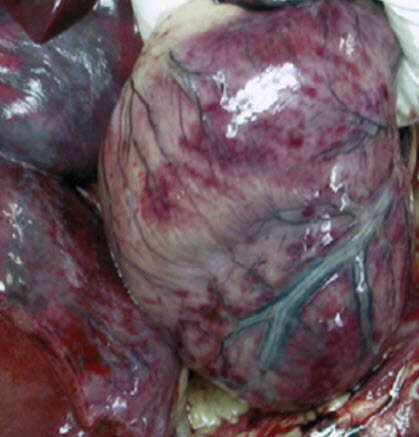Heat stroke pathophysiology
|
Heat stroke Microchapters |
|
Diagnosis |
|---|
|
Treatment |
|
Case Studies |
|
Heat stroke pathophysiology On the Web |
|
American Roentgen Ray Society Images of Heat stroke pathophysiology |
|
Risk calculators and risk factors for Heat stroke pathophysiology |
Editor-In-Chief: C. Michael Gibson, M.S., M.D. [1]; Associate Editor(s)-in-Chief: Seyedmahdi Pahlavani, M.D. [2],Usama Talib, BSc, MD [3]
Overview
Heat stress means perceived discomfort and physiologic strains during heat exposure. A series of physiologic events occur to adapt heat. These events include thermoregulation (with acclimatization), an acute-phase response, and production of heat shock proteins. If these sequence of actions fails to prevents body from high temperature, heat stress progresses to heat stroke. Thermoregulation, acclimatization, acute phase responses, and heat shock proteins are the important factors in response to heat stroke. Hypothalamus is the center of thermoregulation.[1][2][3][4] Increase in the peripheral body temperature will activate sympathetic response through thermoregulatory action of hypothalamus to deliver more blood flow by vasodilation of surface cutaneous veins. This increase in blood flow will cause sweating. The elevated blood temperature will cause tachycardia, increase in cardiac output, and increase in minute ventilation. [5][6][7] Blood shift from internal organs to the skin may cause decreased visceral perfusion and predispose them to ischemia. Increased sweating will cause loss of salt and water up to 2 liters per hour. Therefore, dehydration may worsen thermoregulation. [7][8]
Pathophysiology
Heat stress means perceived discomfort and physiologic strains during heat exposure. A series of physiologic events occur to adapt heat. These events include thermoregulation (with acclimatization), an acute-phase response, and production of heat shock proteins. If these sequence of actions fails to prevents body from high temperature, heat stress progresses to heat stroke.
| |||||||||||||||||||||||||||||||||||||||||||||||||||||||||||||||||||||||||||||||||||||||||||||||||||||||||||||||||||||||||||||||||||||||||||||||||||||||||||||||||||||||||||||||||||||||||||||||||||||||||||||||||||||||||||||||||||||||||||||||||||||||||||||||||||||||||||||||||||||||||||||||||||||||||||||||
Pathogenesis
Thermoregulation
The core body temperature is set to 37 °C. Thermoregulatory center is located in hypothalamus, every 1 °C in body temperature activates the peripheral and central receptors to maintain core body temperature at 37 °C.[4] Increase in the peripheral body temperature will activate sympathetic response through thermoregulatory action of hypothalamus to deliver more blood flow by vasodilation of surface cutaneous veins. This increase in blood flow will cause sweating. The elevated blood temperature will cause tachycardia, increase in cardiac output, and increase in minute ventilation. [5][6][7] Blood shift from internal organs to the skin may cause decreased visceral perfusion and predispose them to ischemia. Increased sweating will cause loss of salt and water up to 2 liters per hour. Therefore, dehydration may worsen thermoregulation. [7][8]
Acclimatization
The process of body adaptation to heat which, might take up to 3 weeks is called acclimatization. Acclimatization, involves enhancement of cardiovascular performance, activation of the renin–angiotensin–aldosterone axis, salt conservation by the sweat glands and kidneys, an increase in the capacity to secrete sweat, expansion of plasma volume, an increase in the glomerular filtration rate, and an increase in the ability to resist exertional rhabdomyolysis.[9]
Acute-Phase Response
Endothelial cells, leukocytes, and epithelial cells incorporate a variety of cytokines (mainly interleukin-1 and interleukin-6) to protect against tissue injury and promote repair. A similar event occur in sepsis.[10]
Heat-Shock Response
Heat-shock proteins are secreted in response to heat to protect cells from injury. Heat-shock proteins bind to proteins and act as chaperons to prevent them from denaturation. [1][2][3]
Microscopic findings
Severe heat stroke causes vascular congestion and/or hemorrhage, thrombi, increased inflammatory cells, and disruption of architecture in many internal organs including: liver, jejunum, spleen, lungs, and kidneys. Angiotelectasis, congestion, and thickening of the lung matrix are another pathological findings.[11]
Gross pathological findings
Hyperemia and edema associated with microhemorrhages are common pathological findings in post mortem surveys.
References
- ↑ 1.0 1.1 Yang YL, Lin MT (1999). "Heat shock protein expression protects against cerebral ischemia and monoamine overload in rat heatstroke". Am. J. Physiol. 276 (6 Pt 2): H1961–7. PMID 10362676.
- ↑ 2.0 2.1 Li PL, Chao YM, Chan SH, Chan JY (2001). "Potentiation of baroreceptor reflex response by heat shock protein 70 in nucleus tractus solitarii confers cardiovascular protection during heatstroke". Circulation. 103 (16): 2114–9. PMID 11319204.
- ↑ 3.0 3.1 Welch WJ (1992). "Mammalian stress response: cell physiology, structure/function of stress proteins, and implications for medicine and disease". Physiol. Rev. 72 (4): 1063–81. PMID 1438579.
- ↑ 4.0 4.1 Grossman, Moses (1997). "Fever: Basic Mechanisms and Management". JAMA: The Journal of the American Medical Association. 278 (5): 441. doi:10.1001/jama.1997.03550050105047. ISSN 0098-7484.
- ↑ 5.0 5.1 Buono MJ, Sjoholm NT (1988). "Effect of physical training on peripheral sweat production". J. Appl. Physiol. 65 (2): 811–4. PMID 3170430.
- ↑ 6.0 6.1 NELSON N, EICHNA LW (1947). "Thermal exchanges of man at high temperatures". Am. J. Physiol. 151 (2): 626–52. PMID 18901907.
- ↑ 7.0 7.1 7.2 7.3 Adams WC, Fox RH, Fry AJ, MacDonald IC (1975). "Thermoregulation during marathon running in cool, moderate, and hot environments". J Appl Physiol. 38 (6): 1030–7. PMID 1141115.
- ↑ 8.0 8.1 Deschamps A, Levy RD, Cosio MG, Marliss EB, Magder S (1989). "Effect of saline infusion on body temperature and endurance during heavy exercise". J. Appl. Physiol. 66 (6): 2799–804. PMID 2745343.
- ↑ Knochel JP (1990). "Catastrophic medical events with exhaustive exercise: "white collar rhabdomyolysis"". Kidney Int. 38 (4): 709–19. PMID 2232508.
- ↑ Kurahashi K, Kajikawa O, Sawa T, Ohara M, Gropper MA, Frank DW, Martin TR, Wiener-Kronish JP (1999). "Pathogenesis of septic shock in Pseudomonas aeruginosa pneumonia". J. Clin. Invest. 104 (6): 743–50. doi:10.1172/JCI7124. PMC 408437. PMID 10491409.
- ↑ Liu ZF, Li BL, Tong HS, Tang YQ, Xu QL, Guo JQ, Su L (2011). "Pathological changes in the lung and brain of mice during heat stress and cooling treatment". World J Emerg Med. 2 (1): 50–3. PMC 4129731. PMID 25214983.
